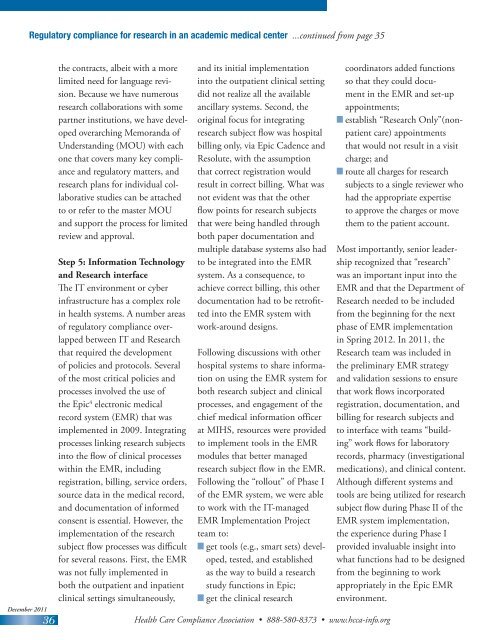Quality of the estimate. December, p. 47 - Health Care Compliance ...
Quality of the estimate. December, p. 47 - Health Care Compliance ...
Quality of the estimate. December, p. 47 - Health Care Compliance ...
Create successful ePaper yourself
Turn your PDF publications into a flip-book with our unique Google optimized e-Paper software.
Regulatory compliance for research in an academic medical center ...continued from page 35<br />
<strong>December</strong> 2011<br />
36<br />
<strong>the</strong> contracts, albeit with a more<br />
limited need for language revision.<br />
Because we have numerous<br />
research collaborations with some<br />
partner institutions, we have developed<br />
overarching Memoranda <strong>of</strong><br />
Understanding (MOU) with each<br />
one that covers many key compliance<br />
and regulatory matters, and<br />
research plans for individual collaborative<br />
studies can be attached<br />
to or refer to <strong>the</strong> master MOU<br />
and support <strong>the</strong> process for limited<br />
review and approval.<br />
Step 5: Information Technology<br />
and Research interface<br />
The IT environment or cyber<br />
infrastructure has a complex role<br />
in health systems. A number areas<br />
<strong>of</strong> regulatory compliance overlapped<br />
between IT and Research<br />
that required <strong>the</strong> development<br />
<strong>of</strong> policies and protocols. Several<br />
<strong>of</strong> <strong>the</strong> most critical policies and<br />
processes involved <strong>the</strong> use <strong>of</strong><br />
<strong>the</strong> Epic 4 electronic medical<br />
record system (EMR) that was<br />
implemented in 2009. Integrating<br />
processes linking research subjects<br />
into <strong>the</strong> flow <strong>of</strong> clinical processes<br />
within <strong>the</strong> EMR, including<br />
registration, billing, service orders,<br />
source data in <strong>the</strong> medical record,<br />
and documentation <strong>of</strong> informed<br />
consent is essential. However, <strong>the</strong><br />
implementation <strong>of</strong> <strong>the</strong> research<br />
subject flow processes was difficult<br />
for several reasons. First, <strong>the</strong> EMR<br />
was not fully implemented in<br />
both <strong>the</strong> outpatient and inpatient<br />
clinical settings simultaneously,<br />
and its initial implementation<br />
into <strong>the</strong> outpatient clinical setting<br />
did not realize all <strong>the</strong> available<br />
ancillary systems. Second, <strong>the</strong><br />
original focus for integrating<br />
research subject flow was hospital<br />
billing only, via Epic Cadence and<br />
Resolute, with <strong>the</strong> assumption<br />
that correct registration would<br />
result in correct billing. What was<br />
not evident was that <strong>the</strong> o<strong>the</strong>r<br />
flow points for research subjects<br />
that were being handled through<br />
both paper documentation and<br />
multiple database systems also had<br />
to be integrated into <strong>the</strong> EMR<br />
system. As a consequence, to<br />
achieve correct billing, this o<strong>the</strong>r<br />
documentation had to be retr<strong>of</strong>itted<br />
into <strong>the</strong> EMR system with<br />
work-around designs.<br />
Following discussions with o<strong>the</strong>r<br />
hospital systems to share information<br />
on using <strong>the</strong> EMR system for<br />
both research subject and clinical<br />
processes, and engagement <strong>of</strong> <strong>the</strong><br />
chief medical information <strong>of</strong>ficer<br />
at MIHS, resources were provided<br />
to implement tools in <strong>the</strong> EMR<br />
modules that better managed<br />
research subject flow in <strong>the</strong> EMR.<br />
Following <strong>the</strong> “rollout” <strong>of</strong> Phase I<br />
<strong>of</strong> <strong>the</strong> EMR system, we were able<br />
to work with <strong>the</strong> IT-managed<br />
EMR Implementation Project<br />
team to:<br />
n get tools (e.g., smart sets) developed,<br />
tested, and established<br />
as <strong>the</strong> way to build a research<br />
study functions in Epic;<br />
n get <strong>the</strong> clinical research<br />
<strong>Health</strong> <strong>Care</strong> <strong>Compliance</strong> Association • 888-580-8373 • www.hcca-info.org<br />
coordinators added functions<br />
so that <strong>the</strong>y could document<br />
in <strong>the</strong> EMR and set-up<br />
appointments;<br />
n establish “Research Only”(nonpatient<br />
care) appointments<br />
that would not result in a visit<br />
charge; and<br />
n route all charges for research<br />
subjects to a single reviewer who<br />
had <strong>the</strong> appropriate expertise<br />
to approve <strong>the</strong> charges or move<br />
<strong>the</strong>m to <strong>the</strong> patient account.<br />
Most importantly, senior leadership<br />
recognized that “research”<br />
was an important input into <strong>the</strong><br />
EMR and that <strong>the</strong> Department <strong>of</strong><br />
Research needed to be included<br />
from <strong>the</strong> beginning for <strong>the</strong> next<br />
phase <strong>of</strong> EMR implementation<br />
in Spring 2012. In 2011, <strong>the</strong><br />
Research team was included in<br />
<strong>the</strong> preliminary EMR strategy<br />
and validation sessions to ensure<br />
that work flows incorporated<br />
registration, documentation, and<br />
billing for research subjects and<br />
to interface with teams “building”<br />
work flows for laboratory<br />
records, pharmacy (investigational<br />
medications), and clinical content.<br />
Although different systems and<br />
tools are being utilized for research<br />
subject flow during Phase II <strong>of</strong> <strong>the</strong><br />
EMR system implementation,<br />
<strong>the</strong> experience during Phase I<br />
provided invaluable insight into<br />
what functions had to be designed<br />
from <strong>the</strong> beginning to work<br />
appropriately in <strong>the</strong> Epic EMR<br />
environment.

















